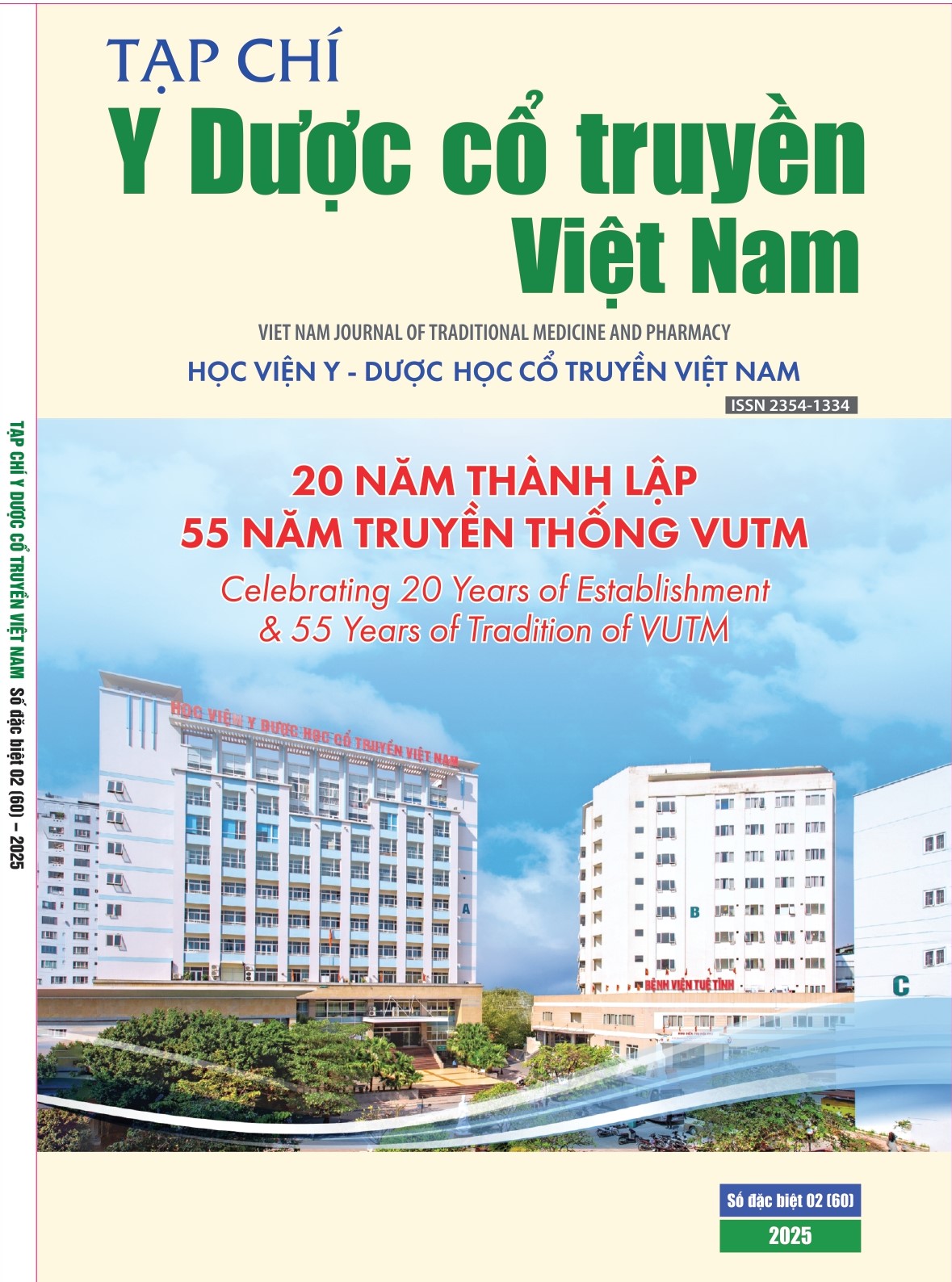Evaluating the analgesic effect of the combination between polydioxanone thread embedding, electroacupuncture and liu-wei-di-huang decoction in patients with lumbar spondylosis at the traditional medicine hospital in Ho Chi Minh city
Main Article Content
Abstract
Objectives: To assess the therapeutic effects and adverse effects of PDO thread embedding combined with electroacupuncture and the oral use of Liu Wei Di Huang decoction in the treatment of chronic lower back pain due to lumbar disc degeneration at the Traditional Medicine Hospital in Ho Chi Minh City.
Subjects and method: 74 patients were randomly divided into 2 groups, with 37 participants in each group. The research group: PDO threads were embedded in acupoints BL23, BL24, BL25, BL26 combined with electroacupuncture. The control group: Sham PDO threads were embedded combined with electroacupuncture. Patients were treated with thread embedding (or sham) every 2 weeks for 4 weeks, followed by an additional week of follow-up. Both groups also received electroacupuncture and herbal decoctions. Outcomes were assessed using VAS and RMDQ at 1, 2, 4, and 5 weeks. Adverse events that occur during the course of the trial were recorded.
Results: After 5 weeks, the research group had a VAS score reduction from 7.87 ± 1.1 to 2.43 ± 0.95, while the control group had a reduction from 7.71 ± 0.83 to 3.74 ± 1.41 (p<0.001). The proportion of patients with good pain relief in the research group was 70.3%, higher than the control group (24.3%) (p<0.05). The RMDQ score significantly decreased in the research group, from 16.8 ± 4.26 to 2.5 ± 2.9, compared to the control group (from 16.7 ± 4.32 to 6.8 ± 4.4) (p<0.001).
Conclusions: PDO thread embedding combined with electroacupuncture is more effective in reducing pain and improving lumbar spine function compared to electroacupuncture alone. No adverse event occurred.
Article Details
References
2. Trịnh Thị Diệu Thường, Lê Thị Hồng Nhung. Hiệu quả điện châm tần số cao trên huyệt Hoa Đà Giáp Tích trong điều trị đau thắt lưng mạn do thoái hóa cột sống thắt lưng, Đại học Y Dược TP.HCM, 2019.
3. Phạm Thị Thanh Xuân. Hiệu quả giảm đau của điện châm các huyệt Giáp Tích L2-S1 phối hợp với các huyệt bổ Thận Tam âm giao, Phục lưu, Thận du trên bệnh nhân đau lưng do thoái hóa cột sống thắt lưng thể Thận âm hư, Đại học Y dược TP.Hồ Chí Minh, 2022.
4. Hồ Ngọc Liểng. Hiệu quả giảm đau trong điều trị đau thắt lưng mạn do thoái hóa cột sống thắt lưng bằng phương pháp cấy chỉ. Tạp chí Y học TP.Hồ Chí Minh, 2018, 24(4), tr.192-198.
5. Price DD, McGrath PA, Rafii A, Buckingham B. The validation of visual analogue scales as ratio scale measures for chronic and experimental pain. Pain, 1983, 17(1), pp.45-56. doi:10.1016/0304-3959(83)90126-4.
6. Boonstra AM, Schiphorst Preuper HR, Balk GA, Stewart RE. Cut-off points for mild, moderate, and severe pain on the visual analogue scale for pain in patients with chronic musculoskeletal pain. Pain, 2014, 155(12), pp.2545-2550. doi:10.1016/j.pain.2014.09.014.
7. Stevens ML, Lin CCW, Maher CG. The Roland Morris Disability Questionnaire. Journal of Physiotherapy, 2016, 62(2), pp.116. doi:https://doi.org/10.1016/j.jphys.2015.10.003.
8. Nguyễn Văn Chiến, Bùi Thị Ngọc Hân, Lê Thị Thu Trang. Hiệu quả của cấy chỉ catgut trong điều trị đau thắt lưng do thoái hóa cột sống. Tạp chí Nghiên cứu Y học, 2021, 140(4), tr.93-102. doi:10.52852/tcncyh.v140i4.137.
9. Kazemi AH, Adel-Mehraban MS, Jamali Dastjerdi M, Alipour R. A comprehensive practical review of acupoint embedding as a semi-permanent acupuncture: A mini review. Medicine, 2024, 103(23), e38314. doi:10.1097/md.0000000000038314.

